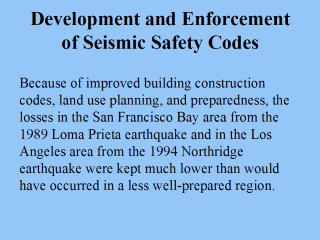| front |1 |2 |3 |4 |5 |6 |7 |8 |9 |10 |11 |12 |13 |14 |15 |16 |17 |18 |19 |20 |21 |22 |23 |24 |25 |26 |27 |28 |29 |30 |31 |32 |review |

|
Aseismic design is
an evolving science, and codes need to be updated periodically to reflect
what has been learned from building performance during actual earthquakes.
Particular attention should be paid to areas in the eastern part of the
United States and in the upper Mississippi River valley, where actual risk
may be higher than perceived and where, consequently, local codes may not be
adequate. How and when and at what expense older buildings should be brought
up to code is a major public health issue since these buildings are likely
to be the most vulnerable. However, the good design required by seismic codes can be negated if builders cut corners on materials and construction techniques. Rigorous enforcement of building codes can prevent shoddy and below-code-level work. |